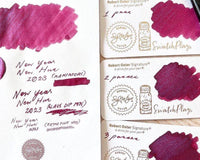Imagine getting ready to start the day by whipping out your trusty notepad (with fountain pen-friendly paper, of course) and your trusty everyday carry fountain pen. You’re looking forward to a productive morning and start to write your to-do list, only to discover that your pen is dry! You draw lines and scribble in an attempt to get it working, but unfortunately, your efforts are in vain.
Few things are as frustrating as writing with a dry fountain pen, but there are ways that your pen can be salvaged. Here, we’ll discuss the various ways that you can fix a dry fountain pen.
Add pressure to the cartridge
If you are using a fountain pen with a cartridge-converter filling system, then one of the things you can do to jumpstart a dry pen is to assist the ink flow. Unscrew the grip section from the barrel to expose the cartridge or converter. Squeeze the far end of the cartridge or converter. Alternatively, you can also twist the knob of the converter. Both of these actions will force ink down through the feed. Wait until the ink has appeared on the nib, wipe off the excess, and then continue writing as usual.
Clean the nib
In some cases, ink may harden in the nib reservoir. This makes it difficult for wet ink to flow through the feed. Cleaning the nib thoroughly can fix this issue. Take a clean, stiff paintbrush or a soft-bristled toothbrush and dip it into warm water with a small amount of dishwashing liquid. Very gently scrub any residue off your fountain pen’s nib. Once the nib is clean, rinse it with tepid water and pat dry with a lint-free cloth. It helps to insert a new ink cartridge or converter and wait a few minutes to check if the ink is flowing. If your pen is still dry, then try the next method.
Flush the fountain pen
Whether you have a new or used writing tool, flushing or cleaning your fountain pen is always helpful in ridding it of any clogs in the nib and feed. New fountain pens may sometimes come with sediment lodged in their parts, while dried ink, especially those with particles like shimmering inks, can harden over time and clog the nib and feed.
Use wetter ink
If your pen is writing but feels a little dry, then it might be time to switch to a wetter ink. Some inks are thicker than others, and some have properties that give them a much less lubricated feel. In smaller-nibbed pens, this may cause skipping and dryness. You can try wetter fountain pen inks, such as those from Sailor Jentle or any from the Pilot Iroshizuku line. Diamine fountain pen inks also tend to run a little wetter and come with a wide selection of colors.
Alter the nib
If none of these methods have fixed your dry fountain pen, then it might be worth reaching out to a nib meister for adjustments. While it is easy enough to make alterations to a nib yourself, we don’t recommend doing this as it may cause permanent damage. The goal is to increase the gap between the tines ever so slightly to accommodate better ink flow.
The bottom line

Having a dry fountain pen is frustrating, but it isn’t the end of your fountain pen’s writing days. There are many ways to remedy a dry pen. It may take a bit of trial and error, but it is an issue that can definitely be fixed.
Happy writing!
Written by EndlessPens Blogger Ramona Kabigting







